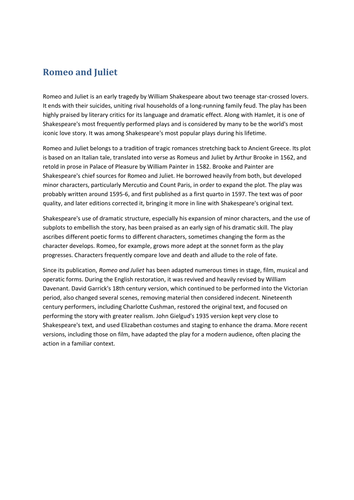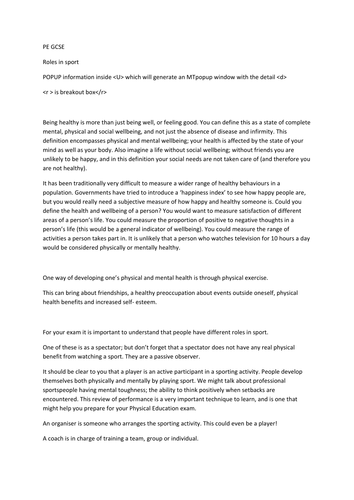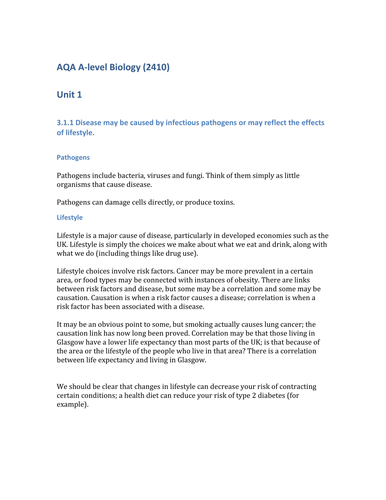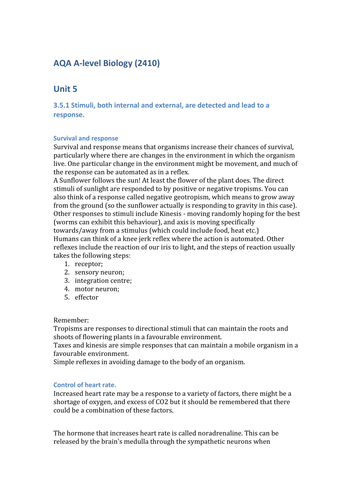
546Uploads
228k+Views
80k+Downloads
All resources

GCSE Biology Multiple choice questions
More than 80 GCSE Biology multiple choice questions.
One copy has no answers, one copy has the correct answer highlighted in bold.
Possible uses include games, revision sessions and so on.

GCSE Drama Multiple choice questions
More than 100 GCSE Drama multiple choice questions.
One copy has no answers, one copy has the correct answer highlighted in bold.
Possible uses include games, revision sessions and so on.

GCSE Citizenship Multiple Choice Questions for OCR (J269 and J029)
GCSE Citizenship Multiple Choice Questions for OCR (J269 and J029)
Almost 200 GCSE Citizenship multiple choice questions. Created for the OCR (J269 and J029) specification.
One copy has no answers, one copy has the correct answer highlighted in bold.
Possible uses include games, revision sessions and so on.

GCE A Level Chemistry Multiple Choice Questions for Unit 5 (AQA board)
GCE A Level Chemistry Multiple Choice Questions for Unit 5 (AQA board)
More than 50 A Level Chemistry multiple choice questions. Created for the AQA (2402) specification.
One copy has no answers, one copy has the correct answer highlighted in bold.
Possible uses include games, revision sessions and so on.

GCE A Level Chemistry Multiple Choice Questions for Unit 4 (AQA board)
GCE A Level Chemistry Multiple Choice Questions for Unit 4 (AQA board)
More than 70 A Level Chemistry multiple choice questions. Created for the AQA (2402) specification.
One copy has no answers, one copy has the correct answer highlighted in bold.
Possible uses include games, revision sessions and so on.

GCE AS Level Chemistry Multiple Choice Questions for Unit 2 (AQA board)
More than 150 AS Level Chemistry multiple choice questions. Created for the AQA (2402) specification.
One copy has no answers, one copy has the correct answer highlighted in bold.
Possible uses include games, revision sessions and so on.

GCE AS Level Chemistry Multiple Choice Questions for Unit 1 (AQA board)
More than 80 AS Level Chemistry multiple choice questions. Created for the AQA (2402) specification.
One copy has no answers, one copy has the correct answer highlighted in bold.
Possible uses include games, revision sessions and so on.

GCE AS Level Business Studies Multiple Choice Questions (Unit 2) for AQA
AS Level Business Studies multiple choice questions.
One copy has no answers, one copy has the correct answer highlighted in bold.
Possible uses include games, revision sessions and so on.

GCE AS Level Business Studies Multiple Choice Questions (Unit 1) for AQA
AS Level Business Studies multiple choice questions.
One copy has no answers, one copy has the correct answer highlighted in bold.
Possible uses include games, revision sessions and so on

GCE A Level Business Studies Multiple Choice Questions for AQA (Legacy spec)
More than 100 A Level Business Studies multiple choice questions.
One copy has no answers, one copy has the correct answer highlighted in bold.
Possible uses include games, revision sessions and so on.

Induction lesson for Computing Year 7
Ever had the problem that students come into year 7 used to their home computers and how the systems worked at their last school? Perhaps you have set up the machines with a default password and need to get them to change that, but also remember that into the coming weeks and months? This lesson has been created to help you.
WALT
• Understand the computer room rules
• Use an algorithm
WILF
• Access the school network
• Access your user area
• Present the classroom rules

GCE AS Level Biology Multiple Choice Questions for Unit 2 for AQA
More than 40 AS Level Biology multiple choice questions.
One copy has no answers, one copy has the correct answer highlighted in bold.
Possible uses include games, revision sessions and so on.

GCE AS Level Biology Unit 2 notes for AQA
GCE AS Level Biology notes written for the AQA specification Biology (2410).
The topics covered in the revision guide are detailed here:
Unit 2
3.2.1 Living organisms vary and this variation is influenced by genetic and environmental factors. Investigating variation
Causes of variation
3.2.2 DNA is an information-carrying molecule. Its sequence of bases determines the structure of proteins, including enzymes. Structure of DNA
Genes and polypeptides
DNA and chromosomes
Meiosis
3.2.3 Similarities and differences in DNA result in genetic diversity. Genetic diversity
3.2.4 The variety of life is extensive and this is reflected in similarities and differences in its biochemical basis and cellular organisation. Haemoglobin
Carbohydrates
Cells
3.2.5 During the cell cycle, genetic information is copied and passed to genetically identical daughter cells. Replication of DNA
Mitosis
Cell cycle
3.2.6 In complex multicellular organisms, cells are organised into tissues, tissues into organs and organs into systems. Cell differentiation
3.2.7 Factors such as size and metabolic rate affect the requirements of organisms and this gives rise to adaptations such as specialised exchange surfaces and mass transport systems. Size and surface area
Gas exchange
Mass transport
The blood system
The passage of water through a plant
3.2.8 Classification is a means of organising the variety of life based on relationships between organisms and is built round the concept of species. Principles of taxonomy
3.2.9 Originally, classification systems were based on observable features but more recent approaches draw on a wider range of evidence to clarify relationships between organisms. Genetic comparisons
DNA
Proteins
Behaviour
3.2.10 Adaptation and selection are major components of evolution and make a significant contribution to the diversity of living organisms. Antibiotics
Genetic variation in bacteria
3.2.11 Biodiversity may be measured within a habitat. Species diversity
Index of diversity

GCE AS Level Biology Unit 1 notes for AQA
GCE AS Level Biology notes written for the AQA specification Biology (2410).
The topics covered in the revision guide are detailed here:
Unit 1
3.1.1 Disease may be caused by infectious pathogens or may reflect the effects of lifestyle Pathogens
Lifestyle
3.1.2 The digestive system provides an interface with the environment. Digestion involves enzymic hydrolysis producing smaller molecules that can be absorbed and assimilated.
The Digestive system
Proteins
Enzyme action
Enzyme properties
Carbohydrate digestion
3.1.3 Substances are exchanged between organisms and their environment by passive or active transport across exchange surfaces. The structure of plasma membranes enables control of the passage of substances across exchange surfaces. Cells
Plasma membranes
Diffusion
Osmosis
Active transport
Absorption
Cholera
3.1.4 The lungs of a mammal act as an interface with the environment. Lung function may be affected by pathogens and by factors relating to lifestyle. Lung function
The biological basis of lung disease
3.1.5 The functioning of the heart plays a central role in the circulation of blood and relates to the level of activity of an individual. Heart disease may be linked to factors affecting lifestyle. Heart structure and function
The biological basis of heart disease
3.1.6 Mammalian blood possesses a number of defensive functions. Principles of immunology

GCE AS Level Biology Multiple Choice Questions for Unit 1 for AQA
More than 40 AS Level Biology multiple choice questions.
One copy has no answers, one copy has the correct answer highlighted in bold.
Possible uses include games, revision sessions and so on.

GCE A Level Biology Multiple Choice Questions for Unit 5 for AQA
More than 50 A Level Biology multiple choice questions.
One copy has no answers, one copy has the correct answer highlighted in bold.
Possible uses include games, revision sessions and so on.

GCE A Level Biology Multiple Choice Questions for Unit 4 for AQA
More than 90 A Level Biology multiple choice questions.
One copy has no answers, one copy has the correct answer highlighted in bold.
Possible uses include games, revision sessions and so on.

GCE A Level Biology Unit 5 notes for AQA
GCE A Level Biology notes written for the AQA specification Biology (2410).
The topics covered in the revision guide are detailed here:
Unit 5
3.5.1 Stimuli, both internal and external, are detected and lead to a response.
3.5.2 Coordination may be chemical or electrical in nature.
3.5.3 Skeletal muscles are stimulated to contract by nerves and act as effectors.
3.5.4 Homeostasis is the maintenance of a constant internal environment.
3.5.5 Negative feedback helps maintain an optimal internal state in the context of a dynamic equilibrium. Positive feedback also occurs.
3.5.6 The sequence of bases in DNA determines the structure of proteins, including enzymes.
3.5.7 Gene expression is controlled by a number of features.
3.5.8 Gene cloning technologies allow study and alteration of gene function in order to better understand organism function and to design new industrial and medical processes.




















